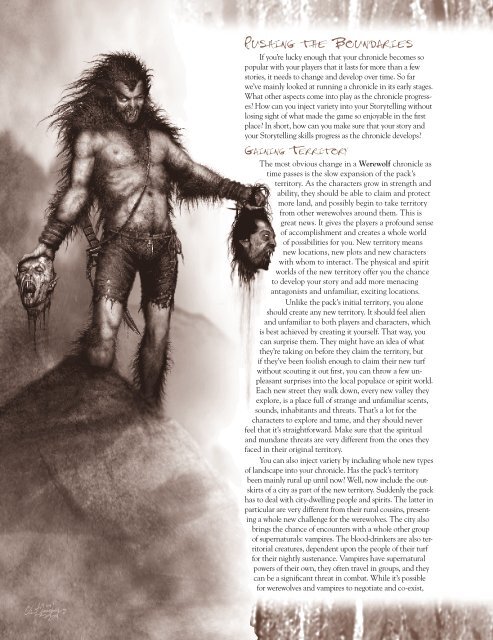Werewolf: The Forsaken - Blank It
Werewolf: The Forsaken - Blank It
Werewolf: The Forsaken - Blank It
You also want an ePaper? Increase the reach of your titles
YUMPU automatically turns print PDFs into web optimized ePapers that Google loves.
232<br />
Chapter IV: Storytelling and Antagonists<br />
PUSHING THE BOUNDARIES<br />
If you’re lucky enough that your chronicle becomes so<br />
popular with your players that it lasts for more than a few<br />
stories, it needs to change and develop over time. So far<br />
we’ve mainly looked at running a chronicle in its early stages.<br />
What other aspects come into play as the chronicle progresses?<br />
How can you inject variety into your Storytelling without<br />
losing sight of what made the game so enjoyable in the first<br />
place? In short, how can you make sure that your story and<br />
your Storytelling skills progress as the chronicle develops?<br />
GAINING TERRITORY<br />
<strong>The</strong> most obvious change in a <strong>Werewolf</strong> chronicle as<br />
time passes is the slow expansion of the pack’s<br />
territory. As the characters grow in strength and<br />
ability, they should be able to claim and protect<br />
more land, and possibly begin to take territory<br />
from other werewolves around them. This is<br />
great news. <strong>It</strong> gives the players a profound sense<br />
of accomplishment and creates a whole world<br />
of possibilities for you. New territory means<br />
new locations, new plots and new characters<br />
with whom to interact. <strong>The</strong> physical and spirit<br />
worlds of the new territory offer you the chance<br />
to develop your story and add more menacing<br />
antagonists and unfamiliar, exciting locations.<br />
Unlike the pack’s initial territory, you alone<br />
should create any new territory. <strong>It</strong> should feel alien<br />
and unfamiliar to both players and characters, which<br />
is best achieved by creating it yourself. That way, you<br />
can surprise them. <strong>The</strong>y might have an idea of what<br />
they’re taking on before they claim the territory, but<br />
if they’ve been foolish enough to claim their new turf<br />
without scouting it out first, you can throw a few unpleasant<br />
surprises into the local populace or spirit world.<br />
Each new street they walk down, every new valley they<br />
explore, is a place full of strange and unfamiliar scents,<br />
sounds, inhabitants and threats. That’s a lot for the<br />
characters to explore and tame, and they should never<br />
feel that it’s straightforward. Make sure that the spiritual<br />
and mundane threats are very different from the ones they<br />
faced in their original territory.<br />
You can also inject variety by including whole new types<br />
of landscape into your chronicle. Has the pack’s territory<br />
been mainly rural up until now? Well, now include the outskirts<br />
of a city as part of the new territory. Suddenly the pack<br />
has to deal with city-dwelling people and spirits. <strong>The</strong> latter in<br />
particular are very different from their rural cousins, presenting<br />
a whole new challenge for the werewolves. <strong>The</strong> city also<br />
brings the chance of encounters with a whole other group<br />
of supernaturals: vampires. <strong>The</strong> blood-drinkers are also territorial<br />
creatures, dependent upon the people of their turf<br />
for their nightly sustenance. Vampires have supernatural<br />
powers of their own, they often travel in groups, and they<br />
can be a significant threat in combat. While it’s possible<br />
for werewolves and vampires to negotiate and co-exist,


